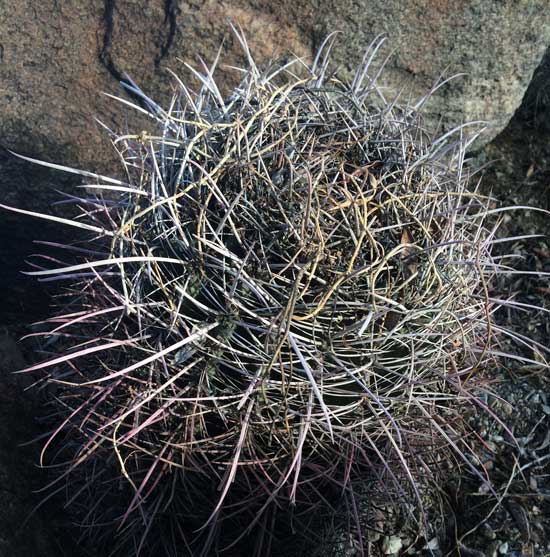Ethnobotany of southern California native plants:
Barrel Cactus (Echinocactus sp. and Ferocactus sp.)

By Jessie Eastland, CC BY-SA 3.0, via Wikimedia Commons
Late blooming barrel cactus in southern California

Barrel cactus in winter near the Salton Sea.
Barrel Cactus (Echinocactus sp. and Ferocactus sp.)
Barrel cacti prominently populate the southwest deserts. Certain species reach 3 feet in height. As the name implies, this cactus is stout and thickly built with well-defined ribs running up and down the plant. After many years of secular growth, flowers appear at the top of the barrel. Eventually, these flowers wilt and are replaced with a fruit that is described as ‘not very tasty’.
Barrel cactus grow based on sun orientation. They often bend to the south in an attempt to dodge the heaviest solar output and prevent a surface tissue sunburn. For this reason, certain species earned the nickname, ‘compass cactus.’
This is also one of the most dangerous cacti, because a puncture from a spine can cause an infection. These dirty wounds may require antibiotics.
In general, Native Americans ate the flowers, the dried seeds and the flesh of these species.
The dried fruit was only collected to serve as emergency food during drought.
Flower buds were often parboiled several times before being eaten. These flower buds were also steamed over a fire or cooked in a stew with wild game. The mature flowers could also be parboiled and eaten.
The Havasupai collected seeds from the fruit and ground them into an edible, porridge mush. These people also warmed the red spines by fire, then bent the spines into finger rings.
Pima natives combined the flesh from this cactus with mequite seed pods for a special dish.
In regards to medicine, Mahuna natives used extracts from the cactus to prevent salivary gland swelling.
The Mahuna employed the barrel cactus spines for fishing hooks.
There is a false theory that a desperate soul – lost in the desert – could save their life by drinking the water inside a barrel cactus. While there is drinkable liquid inside this plant, the water is far too alkaline to do much good. The Seri Indians of the Sonoran Desert have reported headaches, pain and diarrhea upon attempting to drink this water. So, unfortunately, don’t look to the barrel cactus to save the day.
References:
Romero, John Bruno 1954 The Botanical Lore of the California Indians. New York. Vantage Press, Inc. (p. 47)
Weber, Steven A. and P. David Seaman 1985 Havasupai Habitat: A. F. Whiting’s Ethnography of a Traditional Indian Culture. Tucson. The University of Arizona Press (p. 232)
Please return to our main Ethnobotany of southern California page.
On our main ethnobotany page, we present a clickable list of the southern California native plants that became a part of the culture of Native Americans and early European settlers. These plants were used for medicine, food, shelter, drink, tools and art.
Warning: The information about plants on this website is intended for general educational purposes only. The author of this website accepts no responsibility for problems arising from the user’s misidentification, misuse, or use of plants. Please read the full TERMS associated with this website.
